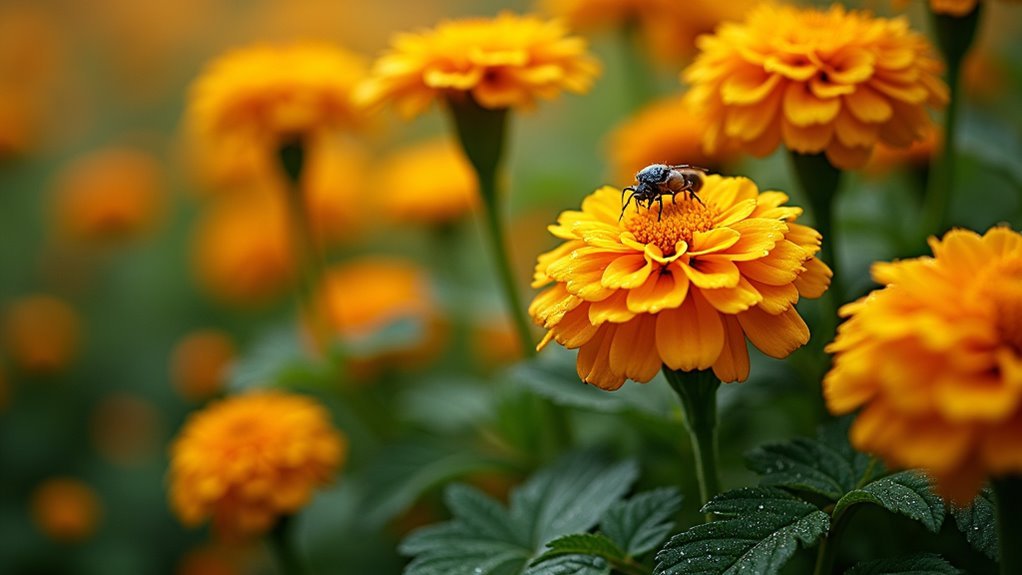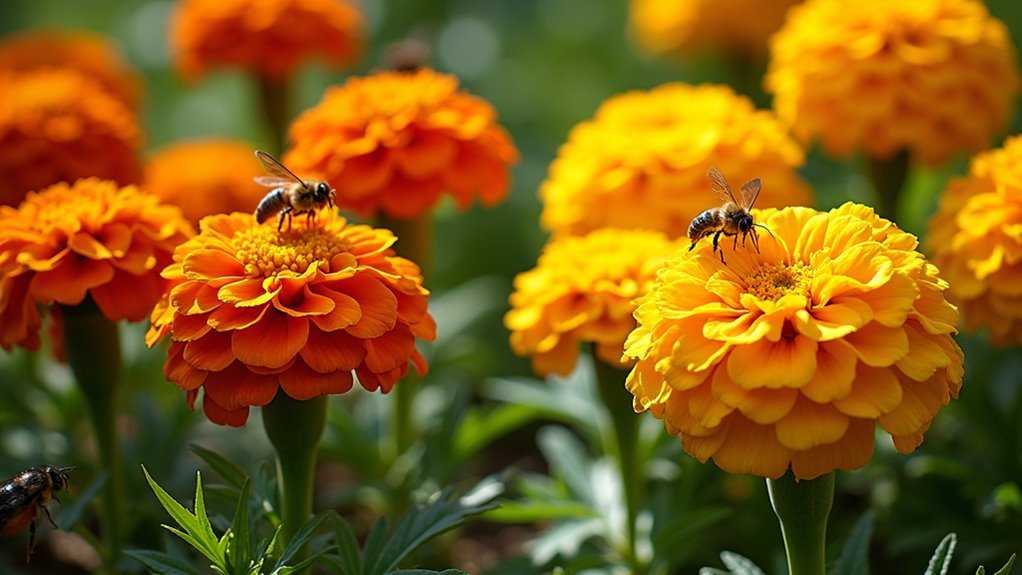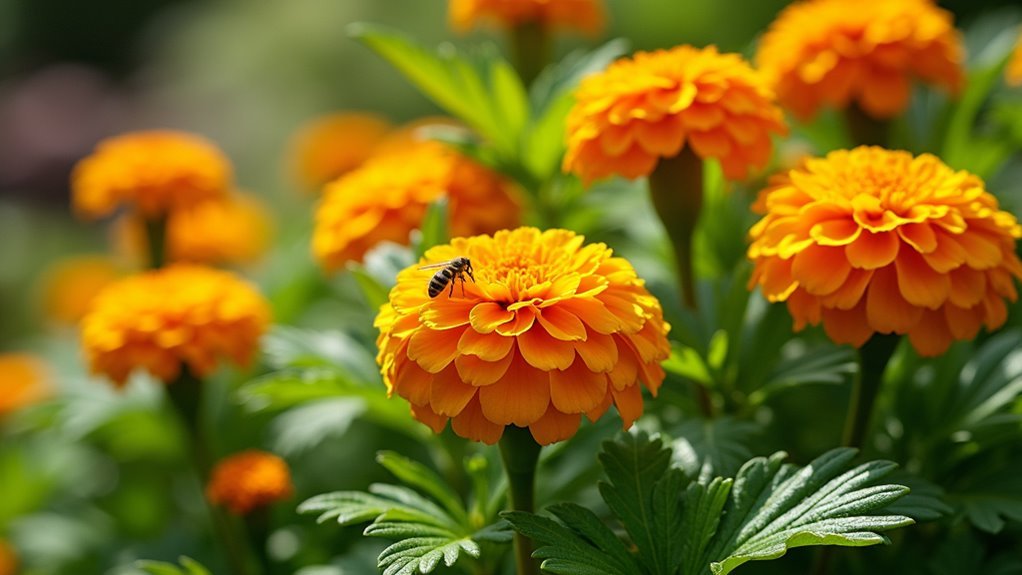You can harness marigolds’ natural pest-fighting power by planting French varieties that release thiophene compounds to deter harmful insects like aphids, whiteflies, and root-knot nematodes. Plant them around garden perimeters and among vulnerable crops, ensuring they receive six hours of daily sunlight for maximum effectiveness. While they’re not a complete solution, marigolds attract beneficial insects and provide chemical-free pest control when combined with other management strategies. Discover how proper timing and placement maximize their garden-protecting potential.
Understanding Marigolds and Their Natural Pest-Fighting Properties

While many gardeners rely on chemical pesticides to protect their plants, marigolds offer a natural alternative that’s been proven effective for centuries. These vibrant flowers pack a powerful punch in pest control through their unique chemical composition. French marigolds (Tagetes patula) are particularly potent, releasing thiophene compounds that create an aromatic barrier against unwanted insects.
You’ll find that marigolds work both above and below ground. Their roots secrete alpha-terthienyl, a toxic substance that prevents root-knot nematode eggs from hatching, effectively breaking the pest’s lifecycle.
Additionally, these flowers attract beneficial insects like ladybugs and parasitic wasps, which naturally hunt down harmful pests. By understanding these natural mechanisms, you can harness marigolds’ dual-action approach to create a healthier, more balanced garden ecosystem.
The Science Behind Marigold Pest Repelling Abilities
The reality behind marigold pest control reveals a more complex picture than traditional gardening wisdom suggests.
The truth about marigold pest control is far more nuanced than popular gardening myths would have you believe.
While you’ve likely heard that marigolds in your garden repel all pests, scientific research tells a different story.
When you plant marigolds, they release thiophene compounds that provide some insect-repelling properties, particularly in French marigold varieties.
However, studies show they don’t effectively deter common garden pests like cabbage or carrot insects.
Here’s what actually happens:
- Marigold roots release alpha-terthienyl, which helps control nematodes by preventing egg hatching.
- Some insects, including aphids and beetles, are actually attracted to marigolds.
- Beneficial insects like hover flies and ladybugs are drawn to marigolds, enhancing natural pest control.
You’ll find marigolds work best as part of integrated pest management rather than standalone repellents.
French Vs African Marigolds: Which Variety Works Best for Pest Control

When you’re selecting marigolds for pest control, you’ll find that French marigolds (Tagetes patula) consistently outperform their African counterparts in repelling garden pests.
French varieties produce a stronger, more potent scent that effectively deters aphids, whiteflies, and other harmful insects, while African marigolds (Tagetes erecta) offer less pest control benefits despite their impressive height and larger blooms.
You’ll get the best results by choosing French marigolds if your primary goal is protecting your garden from pest damage.
French Marigold Advantages
Among gardeners seeking effective pest control, French marigolds (Tagetes patula) stand out as the superior choice over their African counterparts.
You’ll benefit from their unique advantages that make them exceptionally effective at protecting your garden.
French marigolds offer several compelling benefits:
- Chemical warfare: They release thiophene, a powerful compound that deters pests more effectively than African marigolds.
- Space efficiency: Their compact, bushy growth allows you to interplant them between crops, maximizing pest-repelling coverage in confined areas.
- Nematode control: Research confirms they considerably reduce root-knot nematode populations in soil.
You’ll also appreciate their strong scent that repels aphids and whiteflies, plus their continuous blooming throughout the growing season.
This combination makes French marigolds your most reliable companion plant for thorough pest control.
African Marigold Characteristics
| Characteristic | African Marigolds | French Marigolds |
|---|---|---|
| Height | Up to 4 feet | 6-12 inches |
| Flower Size | Large, vibrant | Smaller, continuous |
| Bloom Duration | Shorter period | Until frost |
While African marigolds don’t match French varieties’ pest-repelling chemical concentrations, they’ll still keep pests away through their sheer size and visual deterrent effect. You’ll appreciate their ability to deter larger pests that smaller marigolds can’t handle, though their shorter flowering period means you’ll need strategic planting for season-long protection.
Pest Control Effectiveness
French marigolds outperform African varieties in pest control effectiveness, making them your best choice for natural garden protection.
You’ll get superior results using French marigolds as your primary companion plant because they contain higher thiophene levels that actively repel aphids, whiteflies, and other damaging insects.
When comparing varieties, consider these key advantages of French marigolds:
- Stronger chemical defenses – Their roots release alpha-terthienyl, which effectively controls root-knot nematodes
- Better above-ground protection – More potent scent compounds deter flying pests than African varieties
- Enhanced crop protection – Dense plantings around tomatoes and roses provide maximum pest prevention
You’ll maximize effectiveness by interplanting French marigolds throughout your garden, where they’ll repel harmful pests while attracting beneficial insects for natural pest management.
What Pests Do Marigolds Actually Repel in Your Garden

You’ll find that marigolds effectively repel certain garden pests while surprisingly attracting others, making it essential to understand which insects they actually deter.
These fragrant flowers excel at controlling nematodes and various soil-dwelling pests, plus they can discourage flying insects like aphids and whiteflies through their potent chemical compounds.
However, don’t assume marigolds repel all harmful insects—some common garden myths about their pest-fighting abilities need clarification.
Nematodes and Soil Pests
When it comes to underground pest control, marigolds truly shine in their battle against root-knot nematodes. French marigolds (Tagetes patula) release alpha-terthienyl, a toxic chemical from their roots that specifically targets these destructive soil pests by inhibiting nematode egg hatching.
University of California research demonstrates marigolds’ effectiveness in reducing root galls and boosting yields in subsequent crops, especially tomatoes. You’ll see the most benefits when you incorporate marigolds into your crop rotation strategy.
Here’s what makes marigolds effective against soil pests:
- Chemical warfare: Root-released alpha-terthienyl directly attacks nematode reproduction cycles
- Proven results: Scientific studies show measurable reductions in root damage
- Future protection: Benefits carry over to next season’s plantings
This underground pest control makes marigolds valuable allies in sustainable gardening practices.
Flying Insect Deterrence
While marigolds work wonders beneath the soil surface, they’re equally impressive at deterring flying pests that threaten your garden’s aerial space.
These vibrant flowers emit a potent aroma that effectively repels blackflies, whiteflies, and mosquitoes. The secret weapon lies in thiophene, a natural chemical compound particularly concentrated in French marigolds that acts as nature’s insect repellent.
You’ll find marigolds also deter aphids and wasps, creating additional protection for your vulnerable plants.
To maximize their effectiveness and keep the bugs at bay, plant marigolds densely around your garden’s perimeter or near susceptible crops.
However, remember they’re not a complete solution—combine them with other pest management strategies for ideal protection against flying invaders.
Pest Attraction Myths
How often do gardeners plant marigolds expecting complete pest protection, only to find aphids clustering on the very flowers meant to repel them? The truth challenges widespread gardening folklore about these popular flowers.
Marigolds don’t function as universal pest deterrents despite decades of garden wisdom suggesting otherwise. Research from Rutgers University reveals they’re ineffective against cabbage worms, aphids, and whiteflies.
Even more surprising, they can actually attract certain pests.
Here’s what you should know about marigold pest attraction myths:
- They attract unwanted visitors – Japanese beetles and aphids often target marigolds directly.
- Limited effectiveness – Only root-knot nematodes respond to their alpha-terthienyl chemical defense.
- Scent isn’t foolproof – While pungent, their smell doesn’t reliably deter surface pests.
Understanding these limitations helps you set realistic expectations for marigolds in your pest management strategy.
Debunking Common Myths About Marigold Pest Control
Despite marigolds’ widespread reputation as garden guardians, scientific research reveals a different story about their pest control abilities. You shouldn’t expect marigolds keep all pests away from your garden. Rutgers University studies show they don’t effectively repel common pests like cabbage worms, carrot flies, or onion maggots.
| Common Myth | Scientific Reality | Your Garden Impact |
|---|---|---|
| Marigolds repel all insects | 15+ pests attack marigolds | False security, crop damage |
| Root toxins eliminate pests | Only affects specific nematodes | Limited protection scope |
| Strong scent deters everything | Weak evidence for aroma effects | Disappointed expectations |
When you plant marigolds expecting extensive pest protection, you’re likely setting yourself up for disappointment. The University of Vermont notes they may actually attract certain pests away from crops, but this doesn’t guarantee thorough garden protection.
How Marigolds Control Root-Knot Nematodes Through Soil Chemistry
When you plant Single Gold marigolds (Tagetes patula) in your garden, their roots release alpha-terthienyl, a powerful chemical that prevents root-knot nematode eggs from hatching in the surrounding soil.
This natural compound disrupts the nematode life cycle at its most vulnerable stage, effectively breaking the pest’s ability to reproduce and damage your plants’ root systems.
You’ll need to plan your soil treatment timeline carefully, as these beneficial compounds remain active for up to a year after planting marigolds.
Alpha-Terthienyl Chemical Release
The secret weapon in your marigold’s pest-fighting arsenal lies beneath the soil surface, where their roots continuously release a potent chemical compound called alpha-terthienyl. This naturally occurring toxin specifically targets root-knot nematodes, disrupting their reproductive cycle and preventing egg hatching in your soil.
When you plant marigolds, particularly Tagetes patula varieties, you’re fundamentally installing a biological defense system that works around the clock.
The alpha-terthienyl compound:
- Inhibits nematode egg development, breaking their destructive life cycle
- Persists in soil for extended periods, providing long-term protection
- Allows beneficial soil organisms to thrive while eliminating harmful pests
You’ll notice the most significant benefits the following growing season, when crops planted in marigold-treated soil show dramatically reduced root damage and increased yields.
Nematode Egg Inhibition
Once your marigolds establish their root system, they begin a sophisticated chemical warfare against root-knot nematodes that targets their most vulnerable stage—reproduction.
The alpha-terthienyl compound released by marigold roots specifically prevents nematode eggs from hatching, effectively breaking the pest’s life cycle at its source. This biochemical interference doesn’t just reduce current populations—it prevents future generations from establishing in your soil.
University of California research confirms that this nematode management approach leads to dramatically fewer root galls and increased yields in subsequent crops like tomatoes.
You’ll see the benefits carry into the following growing season as improved soil health supports stronger plant growth. This targeted egg inhibition makes marigolds an invaluable tool for sustainable pest control strategies.
Soil Treatment Timeline
Understanding nematode biology helps you time your marigold plantings for maximum effectiveness.
You’ll need to plant marigolds for at least one full growing season before establishing your target crops. This timeline allows alpha-terthienyl compounds to accumulate in sufficient concentrations to disrupt nematode life cycles.
Here’s your strategic planting schedule:
- Year One: Plant Single Gold variety Tagetes patula across designated areas
- Growing Season: Allow marigolds to establish and release root compounds continuously
- Year Two: Remove marigolds and plant your desired vegetables in treated soil
The nematode-suppressing compounds remain active in soil for approximately one year after marigold removal.
You’ll see the benefits in your vegetable gardens through reduced root galling and improved plant vigor.
Consider soil testing to identify local nematode populations before implementing this timeline.
Strategic Placement: Where to Plant Marigolds for Maximum Pest Protection
While marigolds possess natural pest-repelling properties, their effectiveness depends heavily on where you position them in your garden.
Strategic placement around garden bed perimeters creates a natural barrier that prevents pests from reaching your main crops. You’ll achieve better results by interplanting marigolds directly among vulnerable plants like tomatoes and roses, where they’ll repel pests while attracting beneficial insects.
Plant your marigolds early in the season before pests become active. Choose locations receiving at least six hours of full sun daily, as ideal light exposure increases production of pest-repelling compounds.
Consider using marigolds as trap plants in strategic areas to lure pests away from valuable crops, giving you better control over pest populations throughout your garden.
Companion Planting With Marigolds Around Vegetables and Herbs
You’ll maximize marigolds’ pest-fighting power by understanding which vegetables benefit most from their protective qualities and how to position them strategically throughout your garden.
French marigolds work exceptionally well when planted directly alongside tomatoes, where they’ll greatly reduce whitefly populations while their roots combat harmful nematodes in the soil.
The key lies in creating intentional partnerships between your marigolds and specific crops, then spacing them at ideal distances to form protective barriers without overcrowding your plants.
Strategic Planting Placement Methods
When you’re planning your garden layout, marigolds function best as natural pest deterrents through strategic placement around vulnerable crops.
You’ll maximize their protective benefits by creating dense formations that amplify their pest-repelling scent.
Consider these essential planting strategies:
- Perimeter barriers – Plant marigolds around garden bed edges to block pest entry while enhancing visual appeal.
- Interplanting zones – Position French marigolds directly among tomatoes and roses where their robust aroma confuses harmful insects like aphids and whiteflies.
- Trap plant clusters – Use dedicated marigold sections to lure pests away from valuable crops, creating manageable pest control zones.
Start your marigold planting early in spring before peak pest activity begins.
Dense planting of French marigolds proves most effective, as their concentrated fragrance creates stronger protective barriers throughout your growing season.
Best Vegetable Companion Pairings
Beyond placement strategies, specific vegetable pairings with marigolds create powerful protective partnerships that boost your garden’s productivity.
You’ll find marigolds exceptionally effective when planted alongside tomatoes, where their strong scent deters whiteflies and other harmful pests.
For your cucumber beds, marigolds reduce aphid and beetle populations while enhancing overall plant health and yield.
When growing cabbage and broccoli, you can rely on marigolds’ aromatic properties to ward off destructive cabbage worms.
Pair them with peppers for enhanced pest control while creating visual appeal in your vegetable garden.
Don’t overlook combining marigolds with basil – this pairing offers dual benefits as marigolds handle pest control while basil attracts beneficial pollinators to strengthen your garden’s ecosystem.
Creating Natural Barriers Using Dense Marigold Plantings
Although traditional pest control methods often rely on chemicals, dense marigold plantings offer a natural alternative that creates effective protective barriers around your garden beds.
You’ll find that strategic placement maximizes their pest-deterring potential throughout your growing season.
To establish effective marigold barriers:
- Plant densely around perimeters – Create continuous borders that prevent pests from entering garden spaces
- Interplant between crop rows – Position marigolds directly among vulnerable plants like tomatoes and roses for enhanced protection
- Choose French marigolds – Their strong aroma provides superior deterrent effects against aphids and whiteflies
You should plant before pest activity begins, ensuring your marigolds are established when insects emerge.
Creating clusters near susceptible crops acts as both deterrent and trap, luring pests away from valuable harvests.
Growing and Caring for Pest-Repelling Marigold Varieties
Success with marigold pest control depends on selecting the right varieties and providing proper growing conditions from seed to bloom. French marigolds (Tagetes patula) offer superior pest control capabilities due to their potent scent and higher concentrations of insect-deterring compounds.
| Growing Factor | Requirement |
|---|---|
| Soil pH | 5.8 – 6.2 |
| Sunlight | 6+ hours daily |
| Seed Starting | 2 months before last frost |
| Maintenance | Regular deadheading |
You’ll need well-drained soil within the ideal pH range for robust growth. Test your soil and amend it if necessary. Start seeds indoors about two months before your area’s last frost date, then transplant outdoors once conditions are suitable. Deadhead faded flowers regularly to maintain continuous blooming and maximize pest-repelling effectiveness throughout the growing season.
Attracting Beneficial Insects While Deterring Garden Pests
While marigolds excel at repelling harmful insects, they simultaneously serve as magnets for beneficial garden allies. You’ll attract hover flies, ladybugs, and parasitic wasps that help control harmful pests naturally.
These beneficial insects enhance pollination while maintaining your garden’s ecological balance. The bright colors and extended blooming period of marigolds greatly increase pollinator visits to nearby crops like tomatoes and squash.
By planting marigolds alongside your vegetables and herbs, you’re creating a diverse ecosystem that supports natural pest management strategies.
Research from Penn State University confirms marigolds’ role in promoting healthy garden environments by encouraging diverse insect populations.
Key benefits include:
- Attracting beneficial insects that control aphids and other pests
- Enhancing pollination for improved crop yields
- Creating sustainable pest management without chemicals
Timing Your Marigold Planting for Optimal Pest Management
Strategic timing transforms marigolds from simple garden flowers into powerful pest management tools.
You’ll want to plant marigolds proactively in early spring, ideally two months before your last expected frost. This early timing guarantees they’re well-established before pests emerge, allowing their strong aroma and chemical compounds to develop fully.
Create protective barriers by planting marigolds around garden bed perimeters or interspersing them among your crops.
Don’t wait until pest problems appear—scatter marigolds with other susceptible plants as soon as they’re ready for garden planting.
Maintain continuous protection by monitoring and timing subsequent plantings throughout the growing season.
This approach helps guard against late-season pest invasions when your established marigolds provide ongoing deterrent effects.
Combining Marigolds With Other Natural Pest Deterrent Plants
Maximizing your garden’s pest-fighting power requires pairing marigolds with complementary plants that share their defensive capabilities.
Strategic companion planting creates multiple layers of protection that work synergistically to repel harmful insects while attracting beneficial ones.
Consider these effective plants for pest control combinations:
- Aromatic herbs like basil and lavender enhance marigolds’ deterrent effects by repelling various insects while marigolds attract pollinators.
- Garlic interplanting creates natural barriers against aphids with its strong scent, protecting vulnerable nearby crops.
- Nasturtiums as trap plants lure pests away from valuable vegetables while benefiting from marigolds’ nematode-repelling properties.
French marigolds work particularly well with mint and chrysanthemums, creating diverse ecosystems that deter aphids and spider mites.
This multi-plant approach maximizes your garden’s natural defense system.
Beyond Pest Control: Additional Garden Benefits of Growing Marigolds
Though pest control remains their primary claim to fame, marigolds offer a treasure trove of additional benefits that’ll transform your garden into a thriving, beautiful ecosystem.
Beyond their renowned pest-fighting abilities, marigolds unlock a world of garden magic that creates flourishing, vibrant outdoor sanctuaries.
You’ll enjoy continuous vibrant blooms from spring to frost, creating an inviting atmosphere in your outdoor space.
The benefits of planting marigolds extend to attracting beneficial insects like bees, hoverflies, and ladybugs that enhance pollination and natural pest management.
Your soil health improves considerably as marigold roots release alpha-terthienyl, targeting harmful root-knot nematodes and benefiting future crops.
Starting from marigold seeds, you’ll discover they’re incredibly low-maintenance while delivering exceptional returns.
These versatile flowers support vegetable and herb growth as companion plants, boosting overall garden productivity with minimal effort required from you.
Frequently Asked Questions
Does Planting Marigolds Keep Bugs Away?
You’ll find marigolds don’t effectively repel most garden pests despite popular belief. They may actually attract some insects, making them better trap plants. However, they’re proven effective against soil nematodes through root compounds.
Which Marigolds Are Best for Pest Control?
You’ll want French marigolds for the best pest control. They’re most effective at repelling aphids, whiteflies, and nematodes due to their potent scent and root compounds that deter harmful insects.
What Is the Secret to Growing Marigolds?
You’ll succeed by providing six hours of daily sunlight, maintaining well-drained soil with pH 5.8-6.2, and deadheading spent blooms regularly. Start seeds indoors two months before frost for best results.
What Not to Plant Next to Marigolds?
You shouldn’t plant beans, cabbage family vegetables, carrots, cucumbers, or mint near marigolds. These combinations can cause allelopathy, attract harmful pests, confuse beneficial insects, or create competition that limits growth potential.
In Summary
You’ve discovered that marigolds aren’t just beautiful flowers—they’re powerful allies in your pest management strategy. By choosing the right varieties, planting them strategically, and combining them with complementary plants, you’ll create a natural defense system that protects your garden while attracting beneficial insects. Don’t forget that marigolds offer bonus benefits beyond pest control, making them a smart, multi-purpose addition to any garden space.





Leave a Reply